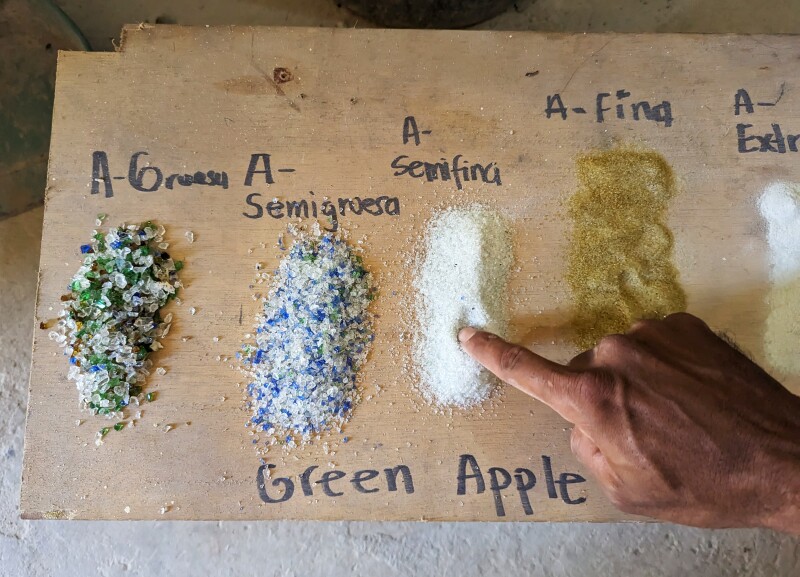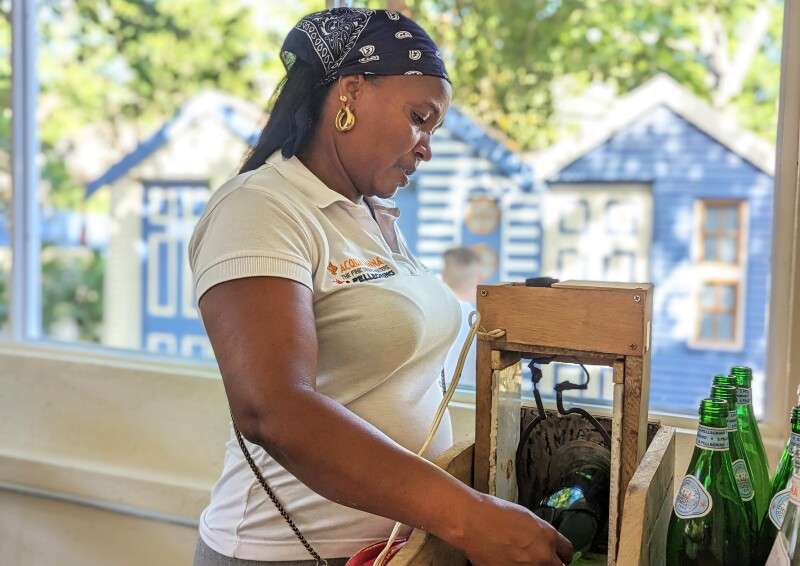Visitors to Cartagena’s bustling Walled City can look across the water and spot a seven-square-mile island off the coast: Tierra Bomba. Home to an estimated 9,000 people, it’s ringed by jagged black coral cliffs and beaches, dotted with brightly colored churches, palms, and kapok trees, and buzzing with barefoot kids on motorbikes. It was once the city’s first line of defense against attacks, raids, and sieges by pirates and armies, and locals recall a time when tourists from around the world flocked here, as they did to the mainland, for shopping, beaches, and historic sites: a 17th-century castle, an 18th-century fort, a vast network of tunnels beneath the island, built by Spanish colonists from massive blocks of coral.
When independent hotelier Portia Hart was looking for a place to open a beach club in 2015, she considered Tierra Bomba. It was the shortest trip from the city. It was beautiful, and with few available jobs and virtually no industry, new businesses had the opportunity to actively and positively contribute to a local community. There were only a few other hospitality businesses on the entire island—small hostel-like beach clubs, with scant amenities. While foreign tourism on the mainland had grown by 500 percent—and the tourism economies of other islands, like the nearby Rosario Archipelago, were flourishing—the number of foreign tourists visiting Tierra Bomba’s once-popular tourist sites had actually dropped over the past 15 years. Colombians call it the “forgotten island.”
“What I thought when I first visited,” Hart recalls, “is ‘Why is no one else here?’”
The answer, she would learn, is complicated, and rooted in Indigenous rights and in the history of the formerly enslaved African and Caribbean people who settled Tierra Bomba. Unlike on any other of Cartagena’s islands, there is no ownership of land here. Residents and business owners can legally occupy an address—but they can’t possess it.
This has led to decades of drama and legal disputes. It’s also been a major deterrent for investors. Watching land disputes drag on, developers once optimistic about the island’s business potential took their money elsewhere, and so did the state: Modern infrastructure, from sewage systems to paved roads to running water, still doesn’t exist. Drinking water comes in on a barge and costs 240 times the mainland rate. The nearest clinic or hospital is accessible only by boat.

Depending on its use, ground glass at Green Apple varies in terms of fineness.
Photo by Alexandra Marvar
To Hart, a 39-year-old, British Trinadadian woman who had just moved from France to Cartagena, Tierra Bomba’s infrastructure problems didn’t seem so insurmountable. In fact, they meant a lack of competition and a warm welcome from locals who were eager for the economic opportunity. In July 2016, she opened Blue Apple Beach, a bright, five-room, six-cabana beachfront escape a few minutes’ motorbike ride down the road from Bocachica, the island’s biggest town.
Soon, however, she realized the biggest problem wasn’t the lack of running water, the unreliable electricity, or the beat-up dock that disappears beneath the waves on blustery days. The island had no trash disposal service. The system in place involved sending waste to above-ground dumping sites in the woods. Eventually much of it made its way to the coastline.
“I think I underestimated the logistical challenges—like most young people going into their first business,” Hart says. But finding a solution was a comedy of errors. After discovering that the hotel trash was being dumped on the island, she began packing it in boats back to the mainland, which she called “extremely expensive and complicated.” From there, Blue Apple Beach tried to cut down on waste in every way possible, bringing on a waste management expert, Caitlin Oliver, who visited the mainland center where they’d been shipping their recycling.
What the team uncovered about glass, in particular, was shocking: Employees told Oliver that they kept storing the glass until the room got full—and then would send it to a landfill, anyway, because there was no market for it. “That was when we discovered that in Cartagena, no one recycles glass,” Hart says. Not even the businesses that thought they had been.
While it is infinitely recyclable, glass can be difficult to process affordably. The United States hasn’t yet cracked the code. Colombia hadn’t either. A recent coastal clean-up nonprofit reported that, in a single day on Tierra Bomba, a troop of volunteers collected more than 100 pounds of glass from the beach and nearby villages—and they’d only covered 3 miles of the approximately 27-mile coastline.
After a long year of trial and error, the Blue Apple team had figured out how to manage every other kind of waste in ways that didn’t wreck the environment. But glass was a problem they were going to have to tackle themselves. They acquired the Colombian coast’s first glass pulverizer and started upcycling glass bottles into products locals could sell for money.
It wasn’t long, Hart says, before other clubs—even her competitors—came asking: Can you help us recycle our glass? By spring of 2018, she’d come up with a solution—the glass recycling and upcycling nonprofit the Green Apple Foundation.
People are interested in making a change not only for themselves, but for their children.
Five years later, it’s early on a balmy February weekday morning in Cartagena. Caracaras soar over the Spanish colonial roof tiles. Parakeets alight from the power lines that hang over the roads along the ancient city wall. Early commuters make their way in the shadow of the clock tower. And a bike trailed by a green-and-white cart clacks over the paver stones in the plaza, emanating the musical clinking of glass.
The man on the bike is going around the Walled City and Getsemaní districts, gathering used bottles from the previous evening’s bar and dinner service. Back on the docks, he and a small crew will soon load bulging plastic mesh bags full of hundreds of pounds of glass onto a boat and set out across the bay.
Meanwhile, at their eventual destination on Tierra Bomba, sunlight fills the front room of a small glassworks studio. Green Apple’s manager of operations, Albert Valiente, leans against the windowsill. His glass processing operation sprawls out behind the scenes in the back of the resort property, but this space behind Blue Apple’s main building is his interface with the public. In the main room, a center table showcases blue, brown, clear, and green glassware for sale.
Green Apple has grown quickly: Today, 27 hotels and restaurants participate, sending six to eight tons of discarded glass per month. Together, they’re diverting hundreds of tons of glass from Cartagena landfills and dumping sites. Valiente’s team crushes about 85 percent of the bottles they gather into a fine sand, which the foundation then sells for use in concrete for construction of buildings like this one. The other 15 percent—the bottles that are too thick for the machine—are transformed into housewares by a staff of six women in the workshop: rocks glasses, tumblers and carafes, and light fixtures.
A Bocachica native, Valiente says he’s seen an interest in recycling grow among island locals. “People are interested in making a change not only for themselves, but for their children,” he says. Tierra Bomba’s fishermen are finding there are fewer fish to catch. The weather patterns are changing, Valiente notes, and coastal erosion is eating away at the land. Close to 60 homes toppled into the water in a matter of just two years according to one report. Locals blame shipping traffic, rising sea levels, and pollution. “It’s changing every day, the environment here,” he says. “As small as this [recycling] is, we want to be able to do something about it.”
Yohiceth Gómez, Valiente’s wife, is one of the six glass artisans who works in the Green Apple workshop. “We’re doing this for the environmental impact that we can bring about through recycling,” Gómez tells me, standing next to her colleague Greisis de Avila in the glass atelier. The money she and her colleagues earn is nice to have, she says, but their primary motivation is helping the planet. “We’re changing the landfill, and now we’re also transforming [the waste], giving it a new life.”
In this past year alone, the artisans have sold more than 2,700 products to more than 150 businesses and individuals. (They split the profits 70/30 with the foundation.) Diners are drinking out of Tierra Bomba–made, upcycled drinking glasses at popular Cartagena cocktail and dining destinations like Caffe Lunático, Celele, Carmen, and El Baron.
Says de Avila, one of three single mothers who works at the workshop several days per week: “Look at everything we’ve already achieved.”

Irina Herrera is one of six local women employed by Green Apple as an artisan.
Photo by Alexandra Marvar
Wheelbarrows carrying today’s glass delivery rumble up from the dock along a sand path. Hart sits barefoot at a table in the sand, surrounded by artist-in-residence Diana Herrera’s paintings of Bocachica residents. She’s having a good day.
“I just had one of the most famous restaurant owners in the country come to me, saying ‘I want to open Green Apple in Medellín this year,’” she says. “What’s been awesome is business owners saying, ‘I want to set up a version of it on my own property. I want to lead a version of it in my own city.’ That’s what we said from day one: We wanted to design something that could be replicated.”
As forgotten as locals felt here for so long, the island’s hospitality scene is booming. Recently, boosted by postpandemic tourism, new clubs have opened one after the next. Upwards of 20 dot the shoreline now, especially on the north edge of the island, where day-tripping revelers can see the Cartagena skyline from beach cabanas and swim-up bars. Three years back, the government established a trash barge carrying waste to the mainland, cutting back further on overground dumping sites.
Hart and Valiente know that as the island develops its tourism scene nearly from scratch, they’re paving a path others can follow. Already, Green Apple has consulted on stand-alone glass recycling facilities at three other Tierra Bomba resorts. Other destinations have struck out on their own and created similar programs, Valiente says, and that makes him proud. “It shows we’re pioneers.”











